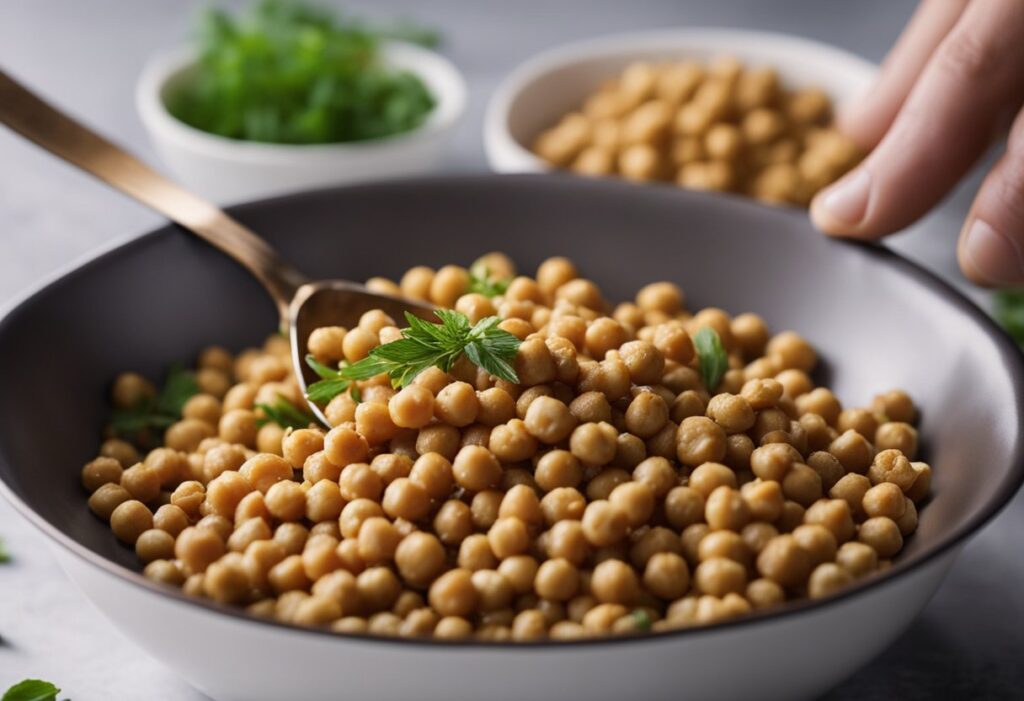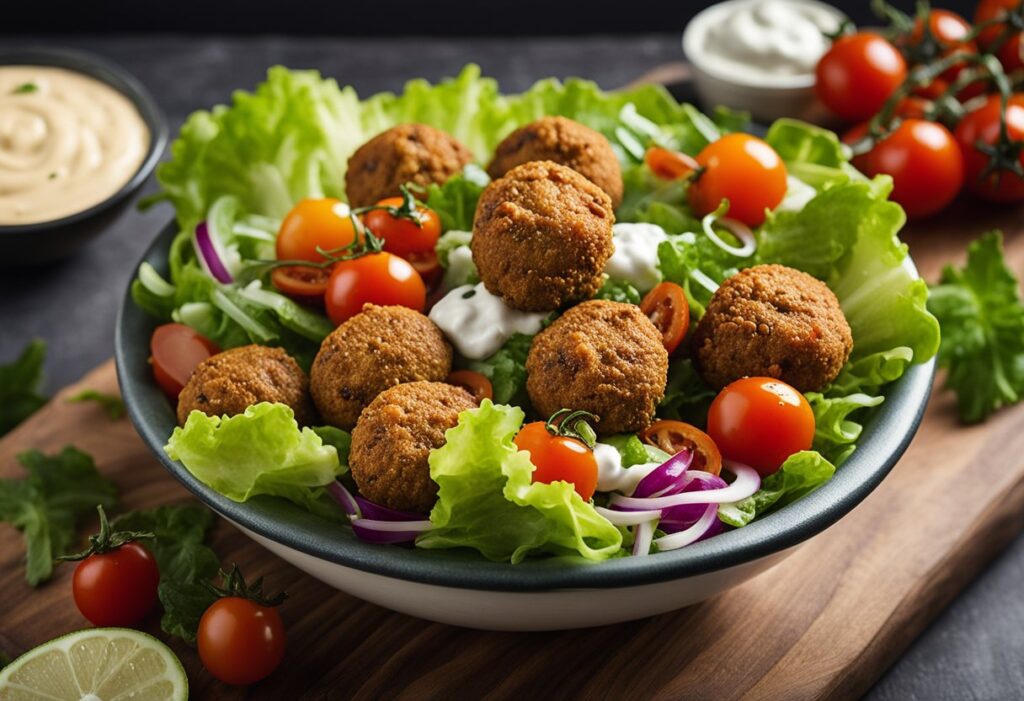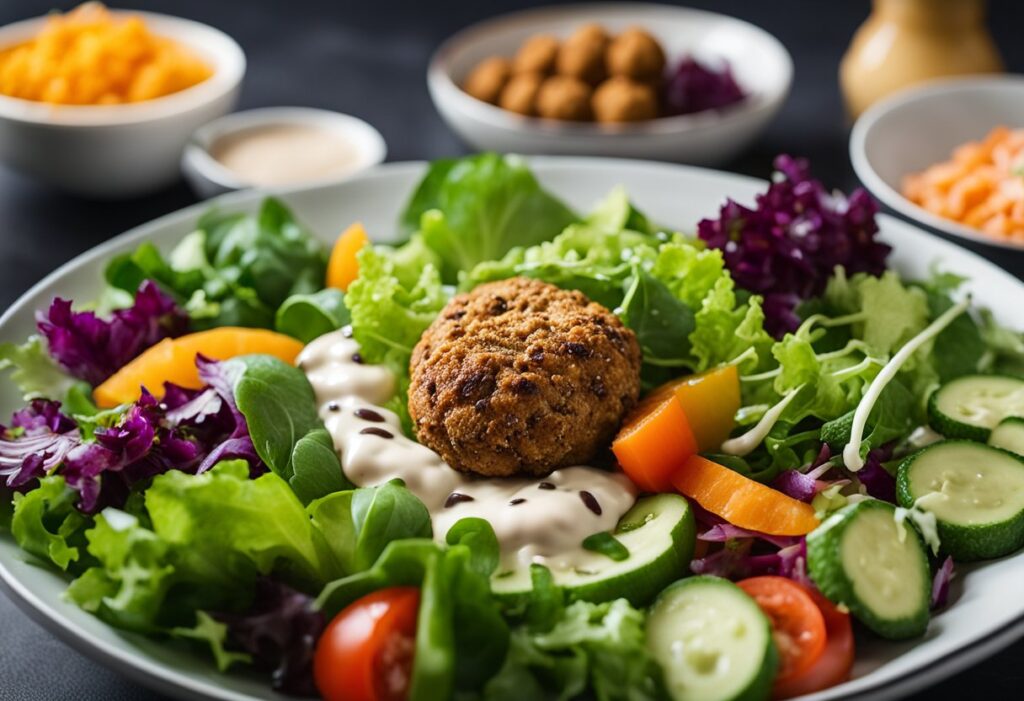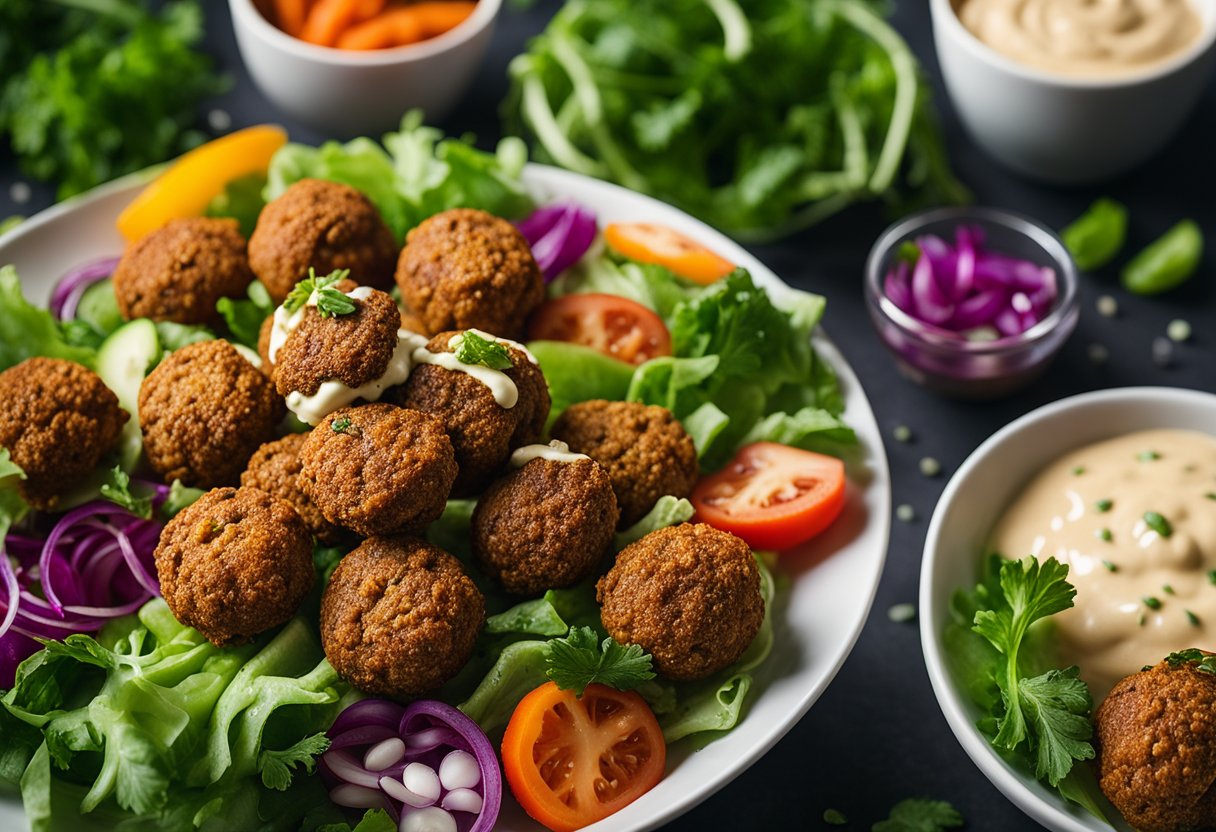Falafel Salad Bowls are a delicious and nutritious meal option that is perfect for those who are looking for a healthy and filling lunch or dinner. This recipe combines the flavors of falafel with fresh vegetables and a tangy dressing, creating a satisfying and flavorful dish.
Table of Contents

To make Falafel Salad Bowls, you will need a few key ingredients, including chickpeas, fresh herbs, and a variety of colorful vegetables. The falafel is made by blending chickpeas, spices, and herbs together in a food processor, and then shaping the mixture into small balls. These are then baked until crispy and golden brown.
Once the falafel is cooked, it is added to a bed of fresh greens and topped with a variety of vegetables, such as cucumber, tomato, and red onion. A simple dressing made from lemon juice, olive oil, and garlic adds a tangy and flavorful finish to the dish. Overall, Falafel Salad Bowls are a healthy and delicious meal option that is perfect for those who are looking for a filling and flavorful plant-based meal.
Essential Ingredients
When it comes to making a delicious falafel salad bowl, there are a few key ingredients that are essential for creating the perfect dish. Here are the must-have ingredients for a mouth-watering falafel salad bowl:
1. Falafel
The star of the show is, of course, the falafel. These tasty little balls are made from ground chickpeas and spices, and are typically deep-fried to create a crispy exterior with a soft, flavorful center. You can make your own falafel from scratch, or purchase pre-made falafel at your local grocery store.
2. Salad Greens
A good falafel salad bowl needs a solid foundation of fresh greens. Choose your favorite lettuce, such as romaine or spinach, and add in some other greens like arugula or kale for added nutrition and flavor.
3. Vegetables
To add some color and crunch to your falafel salad bowl, be sure to include a variety of fresh vegetables. Some great options include diced tomatoes, sliced cucumbers, shredded carrots, and diced bell peppers.
4. Hummus
Hummus is a creamy, flavorful dip made from chickpeas, tahini, lemon juice, and garlic. It’s the perfect addition to any falafel salad bowl, adding a rich, savory flavor and creamy texture.
5. Tzatziki Sauce
Tzatziki sauce is a tangy, garlicky yogurt-based sauce that pairs perfectly with falafel. It’s made with Greek yogurt, cucumber, garlic, and dill, and adds a refreshing, cooling element to the dish.
6. Pita Bread
Finally, no falafel salad bowl is complete without some warm, fluffy pita bread. Use it to scoop up bites of falafel and salad, or simply tear off pieces to enjoy alongside your meal.
Falafel Preparation

To make the perfect falafel salad bowl, it is crucial to prepare the falafel properly. Here are the steps to follow:
- Soak the chickpeas overnight or for at least 8 hours to soften them. Drain and rinse them before using.
- In a food processor, blend the chickpeas, onion, garlic, parsley, cilantro, cumin, coriander, salt, and pepper until a coarse mixture forms.
- Transfer the mixture to a bowl and add flour and baking powder. Mix well until the mixture forms a dough-like consistency.
- Shape the mixture into small balls or patties and place them on a baking sheet lined with parchment paper.
- Refrigerate the falafel for at least 30 minutes to firm up.
- Heat oil in a frying pan over medium-high heat. Once the oil is hot, add the falafel and cook until golden brown, flipping them occasionally to ensure they cook evenly.
- Remove the falafel from the pan and place them on a paper towel to remove excess oil.
By following these steps, you can ensure that your falafel salad bowls are delicious and well-prepared.
Salad Components

The falafel salad bowl is a delicious and healthy meal that is easy to prepare. The salad components are the key to creating a balanced and flavorful dish. Here are some of the essential components of a falafel salad bowl:
Greens
The base of the falafel salad bowl is a bed of fresh greens. Arugula, spinach, and mixed greens are excellent choices that provide a variety of nutrients and flavors. Greens are a great source of vitamins A, C, and K, as well as fiber and antioxidants.
Vegetables
A variety of fresh vegetables can be used to add color, texture, and flavor to the salad bowl. Chopped cucumbers, tomatoes, and bell peppers are classic choices, but other options like shredded carrots, sliced radishes, or roasted sweet potatoes can be used as well. Vegetables are a rich source of vitamins, minerals, and fiber.
Falafel
Falafel is the star of the salad bowl and provides a hearty source of protein and fiber. Traditional falafel is made from ground chickpeas, herbs, and spices, formed into balls, and then fried until crispy. However, baked or air-fried falafel can be used as a healthier alternative.
Dressing
The dressing ties the salad components together and adds a burst of flavor. A simple tahini dressing made with tahini, lemon juice, garlic, and water is a classic choice that complements the flavors of the salad well. Alternatively, a vinaigrette or yogurt-based dressing can be used. Dressings can be made ahead of time and stored in the fridge for convenience.
By combining these salad components, one can create a delicious and nutritious falafel salad bowl that is perfect for any meal.
Dressing Varieties

There are a variety of dressings that can be used to enhance the flavor of falafel salad bowls. The dressing can make or break the dish, so it is important to choose wisely.
Tahini Dressing
Tahini dressing is a classic option for falafel salad bowls. It is made from tahini, lemon juice, garlic, and water. This dressing has a nutty and tangy flavor that complements the falafel and salad greens.
Yogurt Dressing
Yogurt dressing is another popular option for falafel salad bowls. It is made from plain yogurt, lemon juice, garlic, and salt. This dressing has a creamy and tangy flavor that pairs well with the falafel and fresh vegetables.
Lemon Vinaigrette
Lemon vinaigrette is a light and refreshing dressing that adds a citrusy kick to the dish. It is made from lemon juice, olive oil, honey, and Dijon mustard. This dressing is perfect for those who prefer a tangy and sweet flavor.
Garlic Herb Dressing
Garlic herb dressing is a flavorful option for those who prefer a more savory taste. It is made from garlic, parsley, lemon juice, olive oil, and salt. This dressing has a bold and herbaceous flavor that complements the falafel and fresh vegetables.
Overall, the choice of dressing for falafel salad bowls depends on personal preference. Each dressing option has its own unique flavor profile that can enhance the dish in different ways. It is recommended to try different dressing varieties to find the perfect match for your taste buds.
Assembling the Bowl
To assemble the falafel salad bowl, start by dividing the cooked quinoa evenly between four bowls. Then, add a generous handful of mixed greens on top of the quinoa.
Next, add a few spoonfuls of the chopped tomatoes, cucumbers, and red onion to each bowl.
After that, add a few falafel balls to each bowl. You can either place them on top of the vegetables or on a separate side of the bowl.
Drizzle a generous amount of the tahini dressing over the top of each bowl. You can also add a sprinkle of chopped parsley or cilantro for extra flavor and garnish.
Finally, serve immediately and enjoy the delicious and healthy falafel salad bowl.
Serving Suggestions
Serve the falafel salad bowls as a main dish or a side dish. The dish is versatile and can be customized to suit individual tastes. Here are a few serving suggestions:
- Add some sliced avocado or guacamole for a creamy texture and a burst of flavor.
- Top the salad bowls with some crumbled feta cheese for a salty kick.
- Serve with a side of pita bread or naan to soak up the juices and add some carbs to the meal.
- Drizzle some tahini dressing or hummus on top for added flavor and creaminess.
- If you want to make the dish more filling, add some cooked quinoa or brown rice to the salad bowls.
- For a spicy kick, add some sliced jalapenos or a sprinkle of red pepper flakes.
These serving suggestions will help you create a delicious and satisfying meal that is perfect for any occasion. The falafel salad bowls are healthy, flavorful, and easy to make, making them a great option for busy weeknights or lazy weekends.
Storage and Leftovers
After preparing the Falafel Salad Bowls, there might be leftovers that you want to save for later. Proper storage is essential to ensure that the food remains fresh and safe to eat.
If you have leftover falafel, store them in an airtight container in the refrigerator. They can last for up to four days. When reheating, it is best to use an oven or toaster oven to maintain their crispiness.
For the salad, store the vegetables and dressing separately from the falafel to prevent sogginess. Place the vegetables in an airtight container and store them in the refrigerator. The dressing can be stored in a separate container in the refrigerator for up to one week.
When ready to eat, simply combine the vegetables, falafel, and dressing in a bowl and enjoy. The flavors will still be fresh and delicious.
By following these storage guidelines, you can enjoy the Falafel Salad Bowls recipe for multiple meals without compromising its quality.
Nutritional Information
Falafel salad bowls are a healthy and nutritious meal option for those who are looking for a plant-based protein source. They are packed with essential nutrients and vitamins that are vital for maintaining a healthy diet.
One serving of falafel salad bowl contains approximately 400 calories, 20 grams of protein, 40 grams of carbohydrates, and 18 grams of fat. The salad bowl is also rich in fiber, vitamin C, vitamin K, iron, and calcium.
Falafel is made from chickpeas, which are an excellent source of protein, dietary fiber, and complex carbohydrates. Chickpeas are also low in fat and contain essential vitamins and minerals such as iron, magnesium, and potassium.
The salad bowl also contains a variety of fresh vegetables such as lettuce, tomatoes, cucumbers, and red onions. These vegetables are rich in vitamins, minerals, and antioxidants that help to boost the immune system and promote overall health.
The dressing used in the salad bowl is made from tahini, which is a paste made from ground sesame seeds. Tahini is a good source of healthy fats, protein, and essential vitamins and minerals such as vitamin E, calcium, and iron.
Overall, falafel salad bowls are a healthy and nutritious meal option that provides a range of essential nutrients and vitamins. They are easy to prepare, delicious, and perfect for those who are looking for a plant-based protein source.
Common Variations
Falafel salad bowls are a versatile dish that can be customized according to personal preference. Here are some common variations to try:
- Protein: While falafel is a great source of protein, you can also add other protein sources such as grilled chicken, tofu, or shrimp to your salad bowl.
- Vegetables: Feel free to mix and match different vegetables to add variety and nutrition to your salad. Some popular options include cucumbers, tomatoes, bell peppers, red onions, and carrots.
- Grains: If you want to add more texture and fiber to your salad, try adding grains such as quinoa, bulgur, or brown rice.
- Dressing: The dressing is what ties the salad together and adds flavor. You can use store-bought dressings or make your own with ingredients such as olive oil, lemon juice, tahini, garlic, and herbs.
- Spices: Falafel is traditionally made with spices such as cumin, coriander, and paprika. You can experiment with different spice blends to give your salad a unique flavor profile.
By experimenting with different ingredients and flavors, you can create a falafel salad bowl that is both delicious and nutritious.
Kitchen Equipment Required
To make the Falafel Salad Bowls recipe, the following kitchen equipment is required:
- Food processor or blender
- Mixing bowls
- Measuring cups and spoons
- Baking sheet
- Parchment paper or silicone baking mat
- Salad spinner or paper towels
- Chef’s knife or vegetable peeler
- Cutting board
- Serving bowls or plates
A food processor or blender is necessary to make the falafel mixture. Mixing bowls are required to combine the ingredients for the salad dressing and to mix the falafel ingredients. Measuring cups and spoons are needed to measure the ingredients accurately.
A baking sheet lined with parchment paper or a silicone baking mat is necessary to bake the falafel. A salad spinner or paper towels are required to dry the salad greens. A chef’s knife or vegetable peeler is necessary to prepare the vegetables.
A cutting board is required to chop the vegetables and prepare the salad. Finally, serving bowls or plates are needed to serve the falafel salad bowls.

